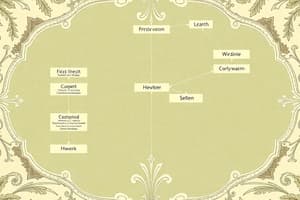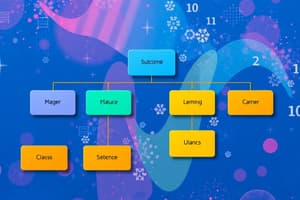Podcast
Questions and Answers
What is the main purpose of a class diagram in UML?
What is the main purpose of a class diagram in UML?
- To model the user interface of a system
- To show the structure of a system (correct)
- To describe the dynamic behavior of a system
- To define the functional requirements of a system
What is represented by a solid line with an open arrowhead in a class diagram?
What is represented by a solid line with an open arrowhead in a class diagram?
- Inheritance (correct)
- Association
- Composition
- Aggregation
What is the purpose of the compartments in a class rectangle?
What is the purpose of the compartments in a class rectangle?
- To display the attributes and operations (correct)
- To show the inheritance relationships
- To represent the multiplicity
- To indicate the role names
What is the difference between aggregation and composition?
What is the difference between aggregation and composition?
What is the purpose of multiplicity in a class diagram?
What is the purpose of multiplicity in a class diagram?
What is represented by a solid line between two classes?
What is represented by a solid line between two classes?
What is the purpose of role names in a class diagram?
What is the purpose of role names in a class diagram?
What is the difference between a class and an object in a class diagram?
What is the difference between a class and an object in a class diagram?
What is the primary function of attributes in a class diagram?
What is the primary function of attributes in a class diagram?
In a class diagram, inheritance is a type of association.
In a class diagram, inheritance is a type of association.
What is the purpose of using meaningful and descriptive names in a class diagram?
What is the purpose of using meaningful and descriptive names in a class diagram?
A class diagram is a type of _______________________ structure diagram.
A class diagram is a type of _______________________ structure diagram.
What is the difference between aggregation and composition?
What is the difference between aggregation and composition?
Match the following types of relationships with their descriptions:
Match the following types of relationships with their descriptions:
A class diagram can be used to show the behavior of a system.
A class diagram can be used to show the behavior of a system.
What is the purpose of the three compartments in a class rectangle?
What is the purpose of the three compartments in a class rectangle?
Flashcards are hidden until you start studying
Study Notes
Class Diagrams
Overview
- A type of static structure diagram used in UML to describe the structure of a system
- Shows the classes, attributes, and operations of a system, as well as the relationships between them
Components of a Class Diagram
- Classes:
- Represented by rectangles with three compartments: name, attributes, and operations
- Can be abstract or concrete
- Attributes:
- Data members of a class, represented by a list of variables inside the class rectangle
- Can have data types, default values, and visibility (public, private, protected)
- Operations:
- Methods or functions of a class, represented by a list of function signatures inside the class rectangle
- Can have parameters, return types, and visibility (public, private, protected)
Relationships between Classes
- Inheritance:
- Represented by a solid line with an open arrowhead, pointing from the subclass to the superclass
- Indicates that a subclass inherits the attributes and operations of a superclass
- Association:
- Represented by a solid line between two classes
- Indicates that one class uses or references another class
- Aggregation:
- Represented by a solid line with a diamond-shaped arrowhead, pointing from the container class to the contained class
- Indicates that one class contains or composes multiple instances of another class
- Composition:
- Represented by a solid line with a filled diamond-shaped arrowhead, pointing from the container class to the contained class
- Indicates that one class contains or composes multiple instances of another class, and the contained class cannot exist independently
Additional Notations
- Multiplicity:
- Indicated by a number or range of numbers near the association, aggregation, or composition line
- Specifies the number of instances of one class that can be related to another class
- Role Names:
- Indicated by a name or label near the association, aggregation, or composition line
- Specifies the role or purpose of the relationship between the classes
Class Diagrams
Overview
- Describe the structure of a system using UML
- Show classes, attributes, and operations, as well as relationships between them
Components of a Class Diagram
Classes
- Represented by rectangles with three compartments: name, attributes, and operations
- Can be abstract or concrete
Attributes
- Data members of a class, listed inside the class rectangle
- Have data types, default values, and visibility (public, private, protected)
Operations
- Methods or functions of a class, listed inside the class rectangle
- Have parameters, return types, and visibility (public, private, protected)
Relationships between Classes
Inheritance
- Represented by a solid line with an open arrowhead, pointing from subclass to superclass
- Subclass inherits attributes and operations of superclass
Association
- Represented by a solid line between two classes
- One class uses or references another class
Aggregation
- Represented by a solid line with a diamond-shaped arrowhead, pointing from container to contained class
- One class contains or composes multiple instances of another class
Composition
- Represented by a solid line with a filled diamond-shaped arrowhead, pointing from container to contained class
- One class contains or composes multiple instances of another class, and the contained class cannot exist independently
Additional Notations
Multiplicity
- Indicated by a number or range of numbers near the association, aggregation, or composition line
- Specifies the number of instances of one class that can be related to another class
Role Names
- Indicated by a name or label near the association, aggregation, or composition line
- Specifies the role or purpose of the relationship between the classes
Class Diagrams
- UML Class Diagrams describe the structure of a system by showing classes, attributes, and relationships.
Elements of a Class Diagram
- Classes are represented by rectangles and can be abstract or concrete.
- Attributes are represented by compartments within the class rectangle and describe the properties of a class.
- Methods are represented by compartments within the class rectangle and describe the operations that can be performed on a class.
- Relationships are represented by lines connecting classes and describe the interactions between classes.
Types of Relationships
- Association describes a relationship between two classes where one class uses or depends on the other.
- Aggregation is a type of association where one class is a collection of objects of another class.
- Composition is a type of aggregation where the contained class cannot exist without the container class.
- Inheritance describes a relationship between a parent class and a child class, where the child class inherits the attributes and methods of the parent class.
- Dependency describes a relationship between two classes, where one class depends on the other, but not necessarily by association.
Notations
- A class is represented by a rectangle with three compartments: class name, attributes, and methods.
- An attribute is represented by a string in the format "name: type".
- A method is represented by a string in the format "name(parameters): return type".
- Relationships are represented by lines with arrowheads and labels.
Best Practices
- Use meaningful and descriptive names for classes, attributes, and methods.
- Keep the diagram simple and focused on the key elements of the system.
- Use notes and comments to provide additional information and context.
- Use stereotypes to extend the UML notation and provide additional information.
Studying That Suits You
Use AI to generate personalized quizzes and flashcards to suit your learning preferences.




